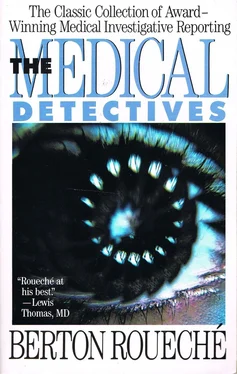Dr. Levy spent an increasingly uneasy weekend. He was of two antagonistic minds. He refused to believe that Sauer's illness was not in some way related to the Schlachtfest of the Hindenburg Pleasure Society. On the other hand, it didn't seem possible that it was. Late Saturday afternoon, at his home, he received a call that increased his discouragement, if not his perplexity. It was from his office. Metropolitan Hospital had called to report that Herman Sauer was dead. Dr. Levy put down the receiver with the leaden realization that, good or bad, the Schlachtfest was now the only lead he would ever have.
On Monday, Dr. Levy buckled heavily down to the essential but unexhilarating task of determining the health of the twenty-seven men and women who had attended the Schlachtfest.
Although his attitude was half-hearted, his procedure was methodical, unhurried, and objective. He called on and closely examined each of the guests, including the Lindenhausers, and from each procured a sample of blood for analysis in the Health Department laboratories. The job, necessarily involving a good deal of leg work and many evening visits, took him the better part of two weeks. He ended up, on April 30th, about equally reassured and stumped. His findings were provocative but contradictory. Of the twenty-seven who had feasted together on the night of March 28, twenty-five were in what undeniably was their normal state of health. Two, just as surely, were not. The exceptions were George Muller and Hans Breit, the men who had provided the pig. Muller was at home and in bed, suffering sorely from what his family physician had uncertainly diagnosed as some sort of intestinal upheaval. Breit was in as bad a way, or worse, in Fordham Hospital. He had been admitted there for observation on April 10. Several diagnoses had been suggested, including rheumatic myocarditis, pleurisy, and grippe, but none had been formally retained. The nature of the two men's trouble was no mystery to Dr. Levy. Both, as he was subsequently able to demonstrate, had trichinosis.
On Friday morning, May 1, Dr. Levy returned to the Bronx for a more searching word with Muller. Owing to Muller's debilitated condition on the occasion of Dr. Levy's first visit, their talk had been brief and clinical in character. Muller, who was now up and shakily about, received him warmly. Since their meeting several days before, he said, he had been enlivening the tedious hours of illness with reflection. A question had occurred to him. Would it be possible, he inquired, to contract trichinosis from just a few nibbles of raw pork? It would. Dr. Levy told him. He also urged him to be more explicit. Thus encouraged, Muller displayed an unexpected gift for what appeared to be total recall. He leisurely recounted to Dr. Levy that he and Breit had bought the pig from a farmer who owned a place near Midvale, New Jersey. The farmer had killed and dressed the animal, and they had delivered the carcass to the Labor Temple kitchen on the evening of March 27. That, however, had been only part of their job. Not wishing to trouble the cook and his helpers, who were otherwise occupied, Muller and Breit had then set about preparing the sausage for the feast. They were both experienced amateur sausage makers, he said, and explained the process—grinding, maccrating, and seasoning—in laborious detail. Dr. Levy began to fidget. Naturally, Muller presently went on, they had been obliged to sample their work. There was no other way to make sure that the meat was properly seasoned. He had taken perhaps two or three little nibbles. Breit, who had a heartier taste for raw pork, had probably eaten a trifle more. It was hard to believe, Muller said, that so little—just a pinch or two—could cause such misery. He had thought his head would split, and the pain in his legs had been almost beyond endurance. Dr. Levy returned him sympathetically to the night of March 27. They had finished with the sausage around midnight, Muller remembered. The cook had departed by then, but his helpers were still at work. There had been five of them. He didn't know their names, but he had seen all or most of them again the next night, during the feast. Neither he nor Breit had given them any of the sausage before they left. But it was possible, of course, since the refrigerator in which he and Breit had stored the meat was not, like some, equipped with a lock. . . Dr. Levy thanked him, and moved rapidly to the door.
Dr. Levy spent the rest of the morning in the Bronx. After lunch, he hopped over to Queens. From there, he made his way to Brooklyn. It was past four by the time he got back to his office. He was hot and gritty from a dozen subway journeys, and his legs ached from pounding pavements and stairs and hospital corridors, but he had tracked down and had a revealing chat with each of Sauer's kitchen colleagues, and his heart was light. Three of them—William Ritter, Rudolf Nath, and Frederick Kreisler—were in hospitals. Ritter was at Fordham, Nath at Queens General, and Kreisler at the Coney Island Hospital, not far from his home in Brooklyn. The fourth member of the group, Henry Kuhn, was sick in bed at home. All were veterans of numerous reasonable but incorrect diagnoses, all were in more discomfort than danger, and all, it was obvious to Dr. Levy's unclouded eye, were suffering from trichinosis. Its source was equally obvious. They had prowled the icebox after the departure of Muller and Breit, come upon the sausage meat, and cheerfully helped themselves. They thought it was hamburger.
Before settling down at his desk to compose the final installment of his report, Dr. Levy looked in on Dr. Greenberg. He wanted, among other things, to relieve him of the agony of suspense. Dr. Greenberg gave him a chair, a cigarette, and an attentive ear. At the end of the travelogue, he groaned. "Didn't they even bother to cook it?" he asked.
"Yes, most of them did," Dr. Levy said. "They made it up into patties and fried them. Kuhn cooked his fairly well. A few minutes, at least. The others liked theirs rare. All except Sauer. He ate his raw."
"Oh," Dr. Greenberg said.
"Also," Dr. Levy added, "he ate two."
[1950]
CHAPTER 3
A Game of Wild Indians
During the second week in August, 1946, an elderly man, a middle-aged woman, and a boy of ten dragged themselves, singly and painfully, into the Presbyterian Hospital, in the Washington Heights section of Manhattan, where their trouble was unhesitatingly identified as typhoid fever. This diagnosis was soon confirmed by laboratory analysis, and on Thursday morning, August 15th, a report of the outbreak was dutifully telephoned to the Department of Health. It was received and recorded there, in accordance with the routine in all alarms of an epidemiological nature, by a clerk in the Bureau of Preventable Diseases named Beatrice Gamso. Miss Gamso is a low-strung woman and she has spent some thirty callousing years in the Health Department, but the news gave her a turn. She sat for an instant with her eyes on her notes. Then, steadying herself with a practiced hand, she swung around to her typewriter and set briskly about dispatching copies of the report to all administrative officers of the Department. Within an hour, a reliable investigator from the Bureau was on his way to Washington Heights. He was presently followed by one of his colleagues, a Department public-health nurse, several agents from the Bureau of Food and Drugs, and an inspector from the Bureau of Sanitary Engineering.
Typhoid fever was among the last of the massive pestilential fevers to yield to the probings of medical science, but its capitulation has been complete. It is wholly transparent now. Its clinical manifestations (a distinctive rash and a tender spleen, a fiery fever and a languid pulse, and nausea, diarrhea, and nosebleed), its cause (a bacillus known as Eberthella typhosa) , and its means of transmission have all been clearly established. Typhoid is invariably conveyed by food or drink contaminated with the excreta of its victims. Ordinarily, it is spread by someone who is ignorant, at least momentarily, of his morbid condition. One reason for such unawareness is that for the first several days typhoid fever tends to be disarmingly mild and indistinguishable from the countless fleeting malaises that dog the human race. Another is that nearly five per cent of the cases become typhoid carriers, continuing indefinitely to harbor a lively colony of typhoid bacilli in their systems. The existence of typhoid carriers was discovered by a group of German hygienists in 1907. Typhoid Mary Mallon, a housemaid and cook who was the stubborn cause of a total of fifty-three cases in and around New York City a generation ago, is, of course, the most celebrated of these hapless menaces. About seventy per cent, by some unexplained physiological fortuity, are women. The names of three hundred and eighty local carriers are currently on active file in the Bureau of Preventable Diseases. They are called on regularly by public-health nurses and are permanently enjoined from any employment that involves the handling of food. More than a third of all the cases that occur here are traced to local carriers but, because of the vigilance of the Health Department, rarely to recorded carriers; new ones keep turning up. Most of the rest of the cases are of unknown or out-of-town origin. A few are attributable to the products of polluted waters (clams and oysters and various greens).
Читать дальше












